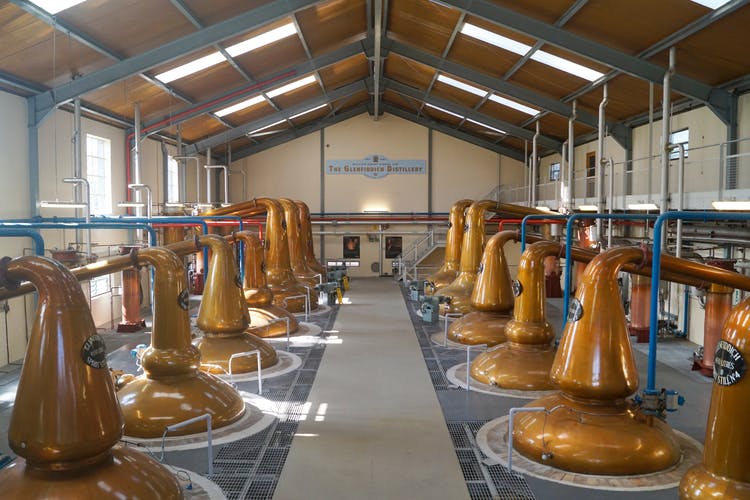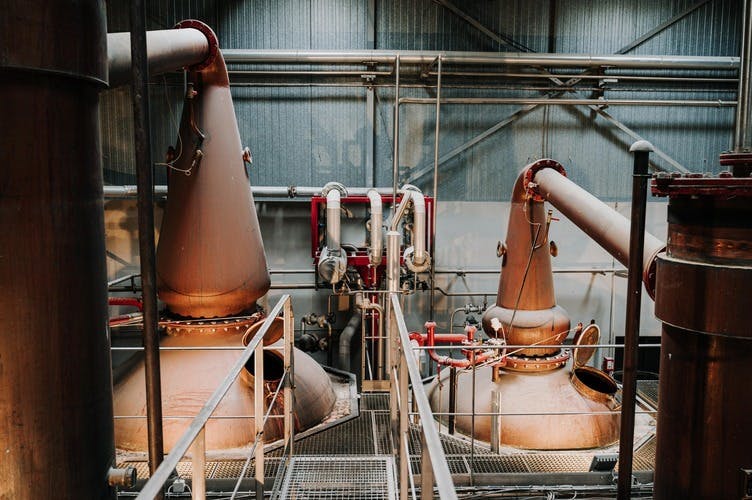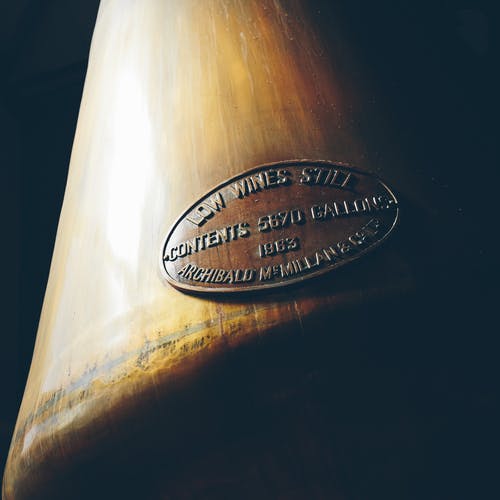
While distilleries swear by the quality of their water, they would never change the shape and size of their precious stills. For both the still and the "art of distillation" shape the character and typicity of the future whisky.
THE STILL IN ALL ITS FORMS
The still used for the distillation of Scottish single malts is of the pot still type. Resembling a kettle topped with a dome, it needs to be cleaned after each use. Its shape varies depending on the distillery. The onion shape and boil ball with a spherical compartment are the most common.
Also noteworthy are the classic pot still or lantern still, which resemble the old illicit stills, the pear shape with its unusual pear-like form, the bell shape that resembles a bell, and the very rare Lomond still, still used by Scapa and The Dalmore, whose dome evokes the cylindrical shape of a patent still, the column still (a continuous distillation process used for grain whisky production).

Regardless of its shape, the copper pot still ends with a swan neck, which is connected to a condenser. The use of copper in the construction of stills is no coincidence. It is a malleable material that acts as a catalyst and helps eliminate undesirable sulfur compounds.
Traditionally heated by coal, direct-heated stills are equipped with rotating arms that drive a chain of copper to prevent the mash (wash) from sticking to the bottom of the still or burning. This device, known as the rummager, is absent from steam-heated stills. These stills, which use an indirect heating method (inside the still), are now the most commonly used.
DOUBLE DISTILLATION
In Scotland, the distillation of single malts typically occurs in two stages, always in pot stills (re-distillation stills), in accordance with regulations.
The beer (wash), obtained after fermentation, is first transferred to one or more large stills called wash stills.
These stills are equipped with viewing ports that allow the operator to monitor the boiling inside the still. The low wines (bas wines), obtained after the condensation of alcohol vapors, typically have an alcohol content of around 25% ABV. They flow through the spirit safe, a true alcohol vault, allowing the stillman (distiller) to precisely measure its density.
The first distillation ends when the liquid remaining at the bottom of the wash still has an alcohol content of no more than 1% ABV. This residue, known as pot ale, represents more than two-thirds of the initial wash. Unlike draff, which is used as livestock feed, pot ale is stored before being collected by tankers for treatment.
The low wines are then transferred to a smaller still, the spirit still, for a second distillation. The first distillate obtained is sent to the alcohol vault for analysis.

Rich in aromatic esters, aldehydes, and acids, the heads of distillation (foreshots) have an alcohol content between 75% and 90% ABV and become cloudy when distilled water is added. Being impure, they are re-distilled with the next batch of low wines. As the distillation continues, the alcohol content decreases.
When the liquid no longer becomes cloudy, the middle cut or heart of the distillation, which is the future whisky, is collected. This typically has an alcohol content between 65% and 75% ABV.
Below 70% ABV, the tails of distillation (feints), rich in sulfur compounds and heavy, powerful aromatic compounds, are re-distilled with the next batch of low wines.
The distillation ends when the liquid still present in the spirit still has an alcohol content of less than 1% ABV. This residue, called spent lees, is treated before being discarded.
INFLUENCE OF STILL AND DISTILLATION ON NEW SPIRIT
The number of distillations, the size and shape of the stills, the distillation speed, the heating process, and even the swan neck angle are all factors that influence the character of the whisky.
In Scotland, most distilleries practice double distillation, but some distilleries in the Lowlands and Speyside have adopted triple distillation, a traditional process in Ireland. Single malts distilled three times tend to be lighter, with elegant floral and fruity notes.
The Springbank distillery in Campbeltown is a special case, as it practices a double and a half distillation. This complex method is difficult to explain but plays a significant role in the character of this single malt.
The size of the still also influences the character of the single malt. The still is heated to the boiling point of alcohol, which is lower than that of water.
The lightest, most volatile alcohol vapors rise easily and pass through the swan neck. The heavier vapors sometimes fall back into the bottom of the still to be re-distilled. Thus, the taller the still, the lighter the whisky will be, as seen at Glenmorangie, which has the tallest stills in Scotland (5.13 meters).
In contrast, a smaller still favors the production of a more robust and oily single malt, as seen with Macallan.

The varied shapes of the pot still are also important. For example, the spherical compartment located between the base and the dome of the boil ball allows the heavier alcohol vapors to descend and be re-distilled, resulting in a lighter whisky.
Additionally, a still heated to very high temperatures speeds up the distillation process, making it more difficult to effectively separate the heads, heart, and tails. In contrast, a slower distillation allows for cleaner cuts, better control over the aromatic profile, and fewer losses.
The swan neck angle plays a role similar to the size of the still. A less inclined neck allows the lightest vapors to move towards the condenser. There are two types of condensers: the traditional worm coils and the more modern U-shaped tube condensers.
Some distilleries have recently chosen to return to the traditional worm coils, proving that even at this stage, whisky can shape its character.

Once the alcohol enters the spirit safe, the distiller's focus is at its peak to determine the interval during which the middle cut will be collected. The taste and character of the future whisky (new spirit) depend largely on this interval.
Thus, the more the new spirit contains heads of distillation, the more it risks incorporating volatile compounds that are undesirable and unsuitable for consumption. The alcoholic strength of the distillate mainly depends on the cut made during the second distillation. Aromatic esters, which contribute to fruity and floral notes, are more concentrated in the middle cut, where the balance between alcohol and aromatic compounds is optimal. Such whiskies tend to be light, marked by pronounced fruity and floral notes.
Conversely, a new spirit rich in tails of distillation is lower in alcohol strength and reveals more richness and aromatic complexity. However, a cut made too late can result in major and irreversible aromatic defects (such as sulfurous or leguminous notes).
It’s all about balance and precision. The lifespan of a pot still varies from twenty to thirty years. Given the importance and specific nature of each component, some distilleries, fearing they may alter the taste of their whisky, even go as far as replicating the imperfections (dips, bumps) in their stills.
TO EXPLORE WHISKIES FURTHER
La Maison du Whisky has three boutiques in Paris:
In each of these boutiques, you'll find a wide selection of whiskies, rums, sakes, and other fine spirits.
Because a whisky can be described in a thousand words, our experts will be delighted to guide you through the must-try whiskies at La Maison du Whisky.
Follow our tasting calendar for upcoming events, or visit the Golden Promise Whisky Bar, which offers an extensive selection of whiskies and other spirits by the glass.
Discover all our other articles on the blog
Written by
- Quentin JEZEQUEL - SEO project manager at LMDW.
Verified by
- Didier GHORBANZADEH - Wine & Spirits Expert at LMDW
- Clotilde NOUAILHAT - Editorial and Corporate Communications Manager at LMDW